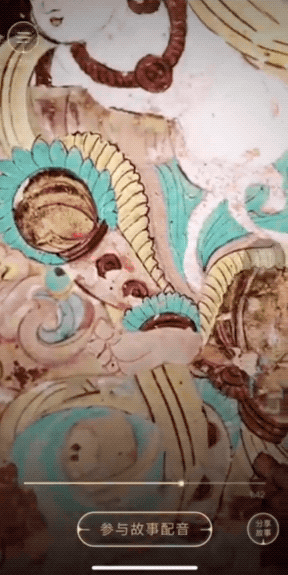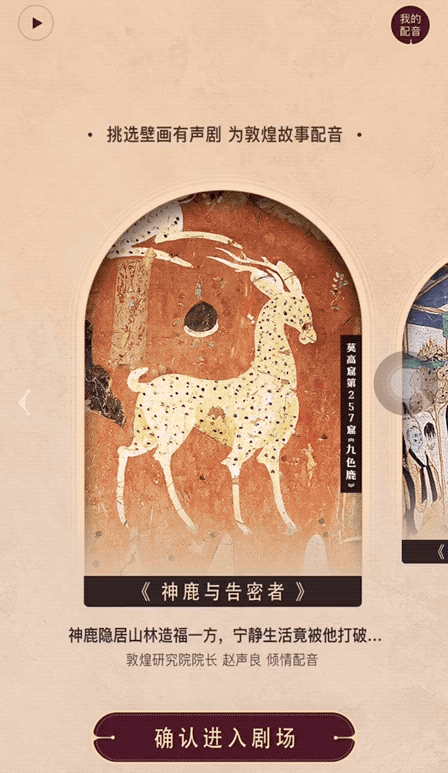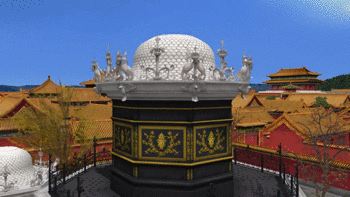Editor's note: The coronavirus epidemic limited people to experience cultural heritage at home, which highlights the importance of cultural digitalization.
A five-episode cartoon series based on frescos of the Mogao Grottoes, a UNESCO World Heritage Site, has gone viral recently.
With the digitalized repair and restoration of the frescos and the animation of characters, stories behind the frescos came alive, including the well-known "A Deer of Nine Colors" and "Playing Pipa behind the back."
Via the online grottoes touring program "Yunyou Dunhuang" on social platforms WeChat or QQ on the smartphones, people can not only watch the cartoons but also dub for the characters.
The popular cartoon series is just among a couple of creative cultural productions enlisted in the "Yunyou Dunhuang" program, which also includes an interactive game of coloring frescos and a VR cave exploration.

A gif of cartoon "Playing Pipa behind the back" based on frescos of the Mogao Grottoes. /Via program "Yunyou Dunhuang"
A gif of cartoon "Playing Pipa behind the back" based on frescos of the Mogao Grottoes. /Via program "Yunyou Dunhuang"
Officially launched on February 20 after the Mogao Grottoes was temporarily closed due to coronavirus outbreak, the program had increased to 3.3 million users by attracting 1.8 million new comers and page views exceeded 12 million in a week. Among them, more than 100,000 users participated in dubbing for cartoon characters.
First constructed in 366 AD more than 1,600 years ago, the Mogao Grottoes are home to collections of Buddhist artwork – more than 2,000 colored sculptures and 45,000 square meters of murals – in 735 caves carved along a cliff by ancient worshipers.
"We have continued explore how to display Dunhuang culture with digitalization," said Zhao Shengliang, head of the Dunhuang Academy.
"I Hope the program 'Yunyou Dunhuang' let friends around the world get closer to Dunhuang, learn knowledge from the treasures of Dunhuang, enjoy the beauty of art, and get inspiration for new creations."
The Dunhuang Academy has been exploring digitization since 1993 by collecting, processing and storing images, videos and 3D data of the caves and cultural relics in a digital resources base.

A gif of the five-episode cartoon series based on frescos of the Mogao Grottoes. /Via program "Yunyou Dunhuang"
A gif of the five-episode cartoon series based on frescos of the Mogao Grottoes. /Via program "Yunyou Dunhuang"
According to data from the Dunhuang Academy, as of January, the academy has completed the image collection of 221 caves, image processing of 135 caves, and created virtual tours for 130 caves.
On the official website of Digital Dunhuang, internet users can view a total of 4,430 square meters of frescos in 30 caves created through ten dynasties in Chinese history.
The Mogao Grottoes is not alone in digitalization exploration.
In the past more than 20 years, the Palace Museum has collected the images of 570,000 cultural relics, and completed the 3D digitalization of more than 1,100 cultural relics and 50,000 square meters of ancient royal buildings.
Years of digitalization have produced fruitful results. The Palace Museum has rolled out more than a dozen of digitalized products, among which seven were published at once in July of last year.

A gif of the program "V Palace Museum" offering VR tours of the museum. /Via program "V Palace Museum"
A gif of the program "V Palace Museum" offering VR tours of the museum. /Via program "V Palace Museum"
They include the applications featuring high-resolution images of the museums' famous paintings, VR tours of the museum, 360-degree view of architectures, and interactive games, music videos and comics.
Wang Xudong, head of the Palace Museum, hoped a digital Palace Museum will "let more common people, especially young people, to involve in the interaction and development of the traditional culture and give it sustainable vitality."
Amid the epidemic, museums and cultural institutions shut their doors and potential visitors shifted their eyes online.
According to the initial estimation of China's National Cultural Heritage Administration, during this year's Spring Festival, more than 1,300 museums introduced over 2,000 online exhibitions with more joining in afterwards. By the end of February, page views exceeded more than five billion.
The epidemic not only changed the museums' service mode but the mode that museums connecting audience, said Liu Yuzhu, head of National Cultural Heritage Administration.